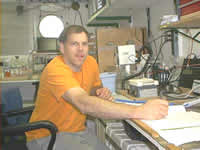| |
| |

Dr. Joe Resing analyzing samples from the
water column on the NeMO CTD Cruise. |
|
R/V Wecoma - CTD Cruise
Science News
Science
Report - Friday, July 30, 2001
Position - 44 20.398' N /129 59.387' W
Joe Resing
If
you've read the previous reports, I think Ed has done a good
job of touching on many of the aspects that go into what happens on an
oceanographic research vessel and more particularly into what happens
during our cruises to study underwater volcanoes. He's probably mentioned,
for instance, that the ship is going 24 hours a day seven days a week.
Well, as fate would have it, I am on the midnight to noon watch. About
10
days into the cruise, my body finally adjusted. As I write this report
it
is 1:00pm and I am getting ready for bed.
I
am an ocean chemist and when I take water from the hydrocasts
that Ed mentioned, I look for chemical clues that will tell me about the
volcano. I measure Fe and Mn which are leached out of the solid lava.
I
also measure pH. Differences in pH tell me how much carbon dioxide gas
is
coming out of the volcanoes. When I combine these chemical clues with
other physical measurements, I get a very good idea about the magmatic
state of the volcano. For the most part, my measurements show a large
decrease in the gas content of the fluids from Axial Volcano, consistent
with the continued decay of volcanic emissions following the eruption
of
Axial in February of 1998. What seems surprising to me is that it is
still pumping out a lot of hot water rich in chemicals. The majority of
underwater eruptions studied so far showed a much more rapid decay in
the
out put of their eruption associated chemicals.
To
make these measurements I use a shipboard chemical analyzer to
measure Fe and Mn, and a pH meter to measure pH (in the picture I am
analyzing another sample for pH). I also operate an instrument that will
measure Fe, Mn, and pH under water. I place the instrument onto the CTD
package and as it is pulled through the water as Ed described I obtain
a
picture of the distribution of these chemicals above the volcano. This
instrument is an in situ chemical analyzer. Oceanographers have a funny
leaning towards making acronyms for everything. For instance my
predecessor, who had this instrument developed by the engineers at the
Pacific Marine Environmental Lab referred to it as the SUAVE (Submersible
Analyzer to Assess Vented Emissions). I found this too cumbersome, and
I
simply refer to it as the Vents In Situ Analyzer or VISA.
Well,
I have one more midnight to noon watch to go and then it is
back to being a daytime person again. We are almost done, and despite
some
equipment problems, this cruise has been extremely successful. We have
collected over 250 samples for salinity, 350 samples of particulate
matter, 400 Helium samples, 550 Fe and Mn samples, and almost 1000 pH
samples. This information will be quite valuable in assessing the current
state of the volcanos along the Juan de Fuca.
|
|

